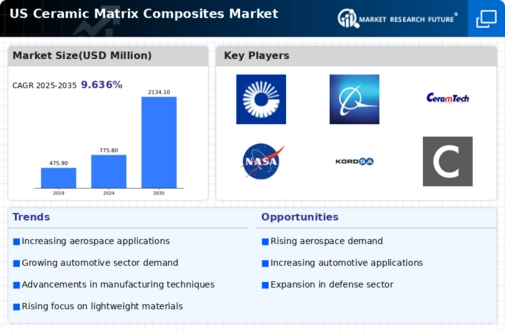The ceramic matrix-composites market is currently characterized by a dynamic competitive landscape, driven by advancements in material science and increasing demand across aerospace, defense, and industrial applications. Key players such as General Electric (US), Northrop Grumman (US), and Raytheon Technologies (US) are strategically positioned to leverage their technological expertise and extensive R&D capabilities. These companies focus on innovation and partnerships to enhance their product offerings and maintain a competitive edge. Their collective strategies not only foster a robust competitive environment but also indicate a trend towards collaborative innovation in the sector.
In terms of business tactics, companies are increasingly localizing manufacturing to reduce lead times and optimize supply chains. The market appears moderately fragmented, with a mix of established players and emerging firms vying for market share. This competitive structure allows for a diverse range of products and services, catering to various customer needs while enhancing overall market resilience.
In October 2025, General Electric (US) announced a partnership with a leading aerospace manufacturer to develop next-generation ceramic matrix-composites aimed at improving fuel efficiency in aircraft engines. This collaboration underscores GE's commitment to innovation and positions it favorably within the aerospace sector, where lightweight materials are critical for performance enhancements.
In September 2025, Northrop Grumman (US) unveiled a new line of ceramic matrix-composites designed for use in advanced military applications. This strategic move not only expands their product portfolio but also aligns with the increasing demand for high-performance materials in defense technologies. The introduction of these composites is expected to enhance the durability and effectiveness of military systems, thereby solidifying Northrop Grumman's market position.
In August 2025, Raytheon Technologies (US) completed the acquisition of a specialized materials company focused on ceramic matrix-composites. This acquisition is likely to bolster Raytheon's capabilities in developing advanced materials for aerospace and defense applications, reflecting a broader trend of consolidation in the market. By integrating this expertise, Raytheon aims to enhance its competitive advantage and drive innovation in its product offerings.
As of November 2025, the competitive trends in the ceramic matrix-composites market are increasingly influenced by digitalization, sustainability, and the integration of AI technologies. Strategic alliances are becoming more prevalent, as companies recognize the value of collaboration in driving innovation and addressing market challenges. Looking ahead, competitive differentiation is expected to evolve, with a shift from price-based competition to a focus on technological advancements, innovation, and supply chain reliability. This transition may redefine market dynamics, emphasizing the importance of sustainable practices and cutting-edge solutions.





















Leave a Comment